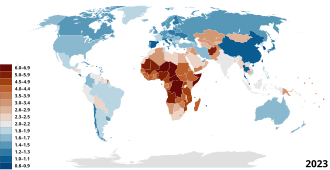
This is a list of all sovereign states and dependencies by total fertility rate (TFR): the expected number of children born per woman in her child-bearing years.

This is a list of all sovereign states and dependencies by total fertility rate (TFR): the expected number of children born per woman in her child-bearing years.
The first lists show the most recent year where there is published total fertility rate (TFR) data ranked by sovereign states and dependencies, and are ordered by organization type – intergovernmental, governmental, or non-governmental organization that searched, organized, and published the data.
Countries are ranked by most recent years’ lists of the following types:
International organizations’ ranking lists
The United Nations ranking list is based on estimates from the World Population Prospects (WPP), published by the United Nations Department of Economic and Social Affairs, Population Division. [1] The World Population Prospects provides the official United Nations demographic estimates and projections, including Total Fertility Rate (TFR), for all countries and territories of the world. These estimates are widely used as a standard reference by international organizations, governments, and researchers, and are derived from analysis of national data sources such as censuses, surveys, and vital registration systems.
The World Bank ranking list is based on the data for the year 2020 published online. [2] The World Bank is a United Nations international financial institution, a component of the World Bank Group, and a member of the United Nations Development Group, but it also collects and analyses information on demography issues based on international and national sources: (1) United Nations Population Division: World Population Prospects, (2) United Nations Statistics Division: Population and Vital Statistics Report (various years), (3) Census reports and other statistical publications from national statistical offices, (4) Eurostat: Demographic Statistics, (5) Secretariat of the Pacific Community: Statistics and Demography Programme, and (6) U.S. Census Bureau International Database.
Note: Sometimes the World Bank changes its figures of fertility rates for a certain year due to more accurate and updated information from sources. Because of that, sometimes it is necessary to update World Bank figures for fertility rates more than once for the same year.
Governmental organizations ranking lists
The CIA ranking list is sourced from the CIA World Factbook for the most recent year [3] [4] unless otherwise specified. Sovereign states and countries are ranked. Some countries might not be listed because they are not fully recognized as countries at the time of this census.
The INED - Institut National d'Études Démographiques is based on the online publication Population & Sociétés - Tous les pays du monde (2019), number 569, September 2019. [5]
Non-governmental organizations ranking lists
The Population Reference Bureau (PRB) ranking list is based on the data of the 2024 World Population Data Sheet [6] published online. The PRB [7] is a private, nonprofit organization which informs people around the world about population, health and the environment for research or academic purposes. It was founded in 1929. World Population Data Sheets are double-sided wallcharts (now published online) that present detailed information on demographic, health and environment indicators for more than 200 countries.
The Our World in Data (OWID) "Total fertility rate: births per woman, 2023" list is sourced and based on the OWID website [8] which includes tables and maps. [9]
Notes:
1- Changes in figures of fertility rates by country from one year to another do not always reflect an actual increase or decrease of fertility rates in a certain country, but instead reflect a change made due to more accurate and updated information from sources.
2- Figures of fertility rates by country and their ranking are based on single referenced sources, from organizations that investigate demographic issues. In several instances, they do not correspond with other sources, such as other organizations and sources that are referenced in the individual demographics by country, which can be accessed by clicking on the names of the countries. These differences can be due to several factors, including primary sources, data quality, and methodology.
Replacement rates
Replacement fertility is the total fertility rate at which women give birth to enough babies to sustain population levels, assuming that mortality rates remain constant and net migration is zero. [10] If replacement level fertility is sustained over a sufficiently long period, each generation will exactly replace itself. [10] The replacement fertility rate is 2.1 births per female for most developed countries (in the United Kingdom, for example), but can be as high as 3.5 in undeveloped countries because of higher mortality rates, especially child mortality. [11] The global average for the replacement total fertility rate, eventually leading to a stable global population, for the contemporary period, 2010–2015, is 2.3 children per female. [11] [12]
|
|
Note: (-) Data unavailable, inapplicable, not collected, or country or dependent territory not included. Sovereign states and dependent territories listed by alphabetical order, not ranked.
Note:
(-) Data unavailable, inapplicable, not collected, or country or dependent territory not included. Sovereign states and dependent territories listed by alphabetical order, not ranked.
|
| ||||||||||||||||||||||||||||||||||||||||||||||||||||||||||||||||||||||||||||||||||||||||||||||||||||||||||||||||||||||||||||||||||||||||||||||||||||||||||||||||||||||||||||||||||||||||||||||||||||||||||||||||||||||||||||||||||||||||||||||||||||||||||||||||||||||||||||||||||||||||||||||||||||||||||||||||||||||||||||||||||||||||||||||||||||||||||||||||||||||||||||||||||||||||||||||||||||||||||||||||||||||||||||||||||||||||||||||||||||||||||||||||||||||||||||||||||||||||||||||||||||||||||||||||||||||||||||||||||||||||||||||||||||||||||||||||||||||||||||||||||||||||||||||||||||||||||||||||||||||||||||||||||||||||||||||||||||||||||||||||||||||||||||||||||||||||||||||||||||||||||||||||||||||||||||||||||||||||||||||||||||||||||||||||||||||||||||||||||||||||||||||||||||||||||||||||||||||||||||||||||||||||||||||||||||||||||||||||||||||||||||||||||||||||||||||||||||||||||||||||||||||||||||||||||||||||||||||||||||||||||||||||||||||||||||||||||||||||||||||||||||||||||||||||||||||||||||||||||||||
Note:
(-) Data unavailable, inapplicable, not collected, or country or dependent territory not included. Sovereign states and dependent territories listed by alphabetical order, not ranked.
Case studies